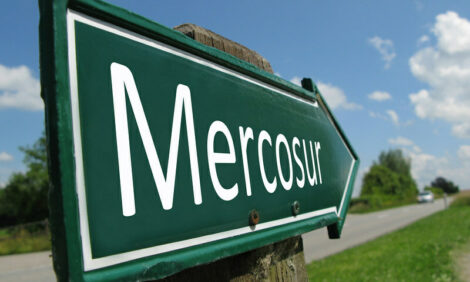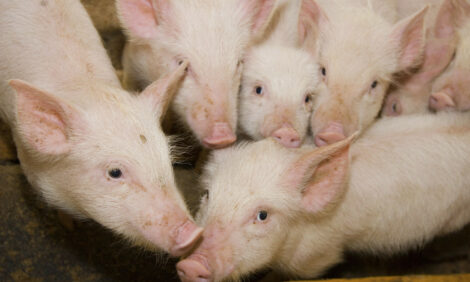



Consumer Expenditure on Pork Increased During 2012
UK - The latest Kantar Consumer Data has indicated that increased expenditure on beef and lamb during the 52 week period ending the 23 December 2012 has increased their market size by five per cent and four per cent respectively in terms of sales value year on year, reports Livestock and Meat Commission Northern Ireland.However while
volume sales of lamb has increased by
five per cent, volume sales of beef have
declined by three per cent when
compared to the corresponding period
in 2011.
Lamb
The latest Kantar data has indicated
strong lamb sales in the UK for the 4,
12 and 52 week periods ending the 23
December 2012. There has been a
strong increase in the sales of lamb leg
roasting joints in particular across all
three time periods. Some of this
increase was at the expense of lamb
shoulder which has experienced a
decline in sales.
Increased promotion
has helped to boost sales with 44 per
cent of all leg joints in the twelve weeks
up to the 23 December 2012 being
sold on promotion.
In the same period
last year promotional sales accounted
for less than 8 per cent of sales.
Total expenditure on lamb for the 52
weeks ending the 23 December
totalled 3615 million, a four per cent
increase in spending on the previous
year. The average retail price during this
period was back one per cent to
38.42/kg with total volume sales up
five per cent on 2011 sales.
Much of this increase has been driven by an
increase in the sales of lamb leg
roasting joints with an additional 339.6
million worth of sales year on year.
However sales of all other cuts have
seen volume declines during the 52
week period, with the exception of
diced lamb which has experienced an
increase in volume sales (+4.6 per
cent). Sales of lamb stewing meat were
back 2.8 per cent, sales of lamb mince
back 5.6 per cent, sales of chop steaks
back 7.5 per cent and sales of lamb
shoulder roasting joints back 10 per
cent year on year.
If we consider the four week period
ending the 23 December 2012 total
expenditure on lamb was nine per cent
higher than in the corresponding period
in 2011 with an increase in the average
retail price by two per cent to 38.07. The
volume sales of lamb increased by
seven per cent when compared to the
same period in 2011 with a six per cent
increase in market penetration
between the two periods.
This increase
in volume sales has been reflected in
an increase in sales volume for the
majority of cuts of lamb. The exception
to this is volume sales of lamb shoulder
roasting joints which were back 19 per
cent between the two periods.
This increase in average price,
expenditure and volume sales in the
four weeks up to 23 December raises
interesting questions about NI
producer’s share of the retail price with deadweight prices for lambs under
pressure during this period.
Beef
Kantar data for the 52 weeks ending
the 23 December 2012 have shown
that volume sales for the majority of
beef cuts have declined when
compared to the previous 52 week
period but that the average retail price
increased by nine per cent to 36.99/kg.
With volume sales back three per cent
it is important to note that the five per
cent increase in expenditure on beef
year on year has come about due to
average price increases and not due to
an increase in volume sales.
However during the four week period
ending the 23 December 2012 volume
sales were three per cent higher than
the same period in 2011 with an
increase in expenditure by eleven per
cent to 3191 million. The average retail
beef price during the four week period
was 37.25, an eight per cent increase
when compared to the corresponding
period in 2011.
In the run up to Christmas beef
frying/grilling steaks sold well with a
16.6 per cent increase in expenditure
when compared to December 2011. A
10 per cent increase in sales of beef
mince in the four week period leading
up to Christmas has helped to increase
volume sales of the beef category.
However sales of beef roasting joints
struggled in the run up to Christmas
with sales back on the corresponding period in 2011. Reduced promotional
activity across the major retailers when
compared to last year will have had a
strong impact on this trend with fewer
shoppers buying beef roasts and
smaller volumes being purchased per
trip.
Pork
When considering beef and lamb sales
it is also important that we consider the
performance of pork as it is a common
alternative to beef and lamb in the
shopping basket.
Expenditure on pork during the 52
week period ending the 23 December
2012 showed an increase of three per
cent year on year. Over the same period
however there has been a three per
cent reduction in volume sales.
The
reduction in volume sales over the year
may be driven to some degree by the
six per cent increase in retail price to
35.15 and this may have helped to
boost beef and lamb sales. While there
have been significant increases in the
sales of loin roasting joints (+22.4 per
cent), marinades (+23.6 per cent) and
pork belly (+13.4 per cent) other cuts
have not performed so well.
Volume
sales of leg roasting joints were back
21.7 per cent, shoulder joints back
12.2 per cent and sales of pork chops
down 9.4 per cent on 2011 figures.
During the four week period leading up
to Christmas 2012 the average price of
pork was eight per cent higher than the
corresponding period in 2011 at 35.50per kg. This increase in price has
resulted in a seven per cent increase in
the total expenditure on pork when
comparing the two four week periods.
As with the 52 week period there has
been mixed performance in the sales of
individual cuts with reductions in sales
of leg roasting joints (-17.4 per cent)
and frying steaks (-10.5 per cent) while
there have been increases in the sales
of loin roasting joints (+25.7 per cent)
and marinades (+61.3 per cent).
Convenience Foods
While the Kantar consumer data
provides us with information on sales
of the major meats the information also
highlights the rising demand for
convenience foods.
Total expenditure
on chilled convenience foods in the UK
during the 52 week period ending the
23 December 2012 totalled 31.8
billion, an eleven per cent increase on
the previous year and represents an
eight per cent growth in volume sales.
Total expenditure on chilled ready
meals increased by seven per cent over
the same period to 31.4 billion with a
one per cent increase in total volume
sales.
These figures serve to highlight the
increasing importance of convenience
foods in today’s retail trade. As volume
sales of the major meats come under
pressure it is important that the
convenience food markets is fully
capitalised on through product
development, assuring quality of
ingredients and effective marketing.








